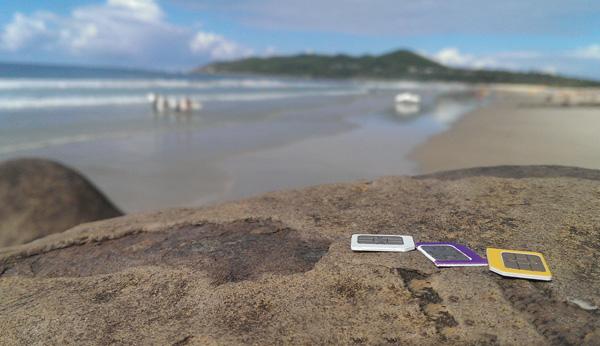SIM cards are fantastic because they offer seamless connectivity and convenience, letting you stay in touch with friends and family, access the internet, and enjoy a range of mobile services. They come in various types and sizes, ensuring compatibility with most devices. Plus, they can be easily swapped or upgraded as needed. If you’re looking to get a new SIM card, it's essential to know how to register sim card tnt to get started with your service without a hitch. Understanding this process will ensure you’re all set up and ready to enjoy the benefits of your new SIM card.
SIM Cards Are Awesome

They’re called SIM cards, and they’re not discussed much in the States, but are commonplace pretty much everywhere else.
SIM is an acronym for Subscriber Identification Module, and is a small chip that basically lets your phone be “you” on a cell network.
Until recently, we Americans couldn’t do much with SIMs. Generally, they came with the phone (sometimes permanently mounted), and instead of switching them out, you just bought a new phone that came with one. Your provider updated your account with the new SIM code, and you went on with your life.
But as mobile phones advance, and carriers are required to do things beneficial for their customers, we can (usually) swap out a SIM card while in a different country, and use their rates instead of the roaming fees charged by domestic carriers. This can save you a lot of money.
During a recent tour through Australia, New Zealand, and parts of SE Asia, I bought 5 different SIMs. They ranged in price between $20 and $30. The more expensive ones tended to come with more data/minutes included. You buy them not just based on how much data/minutes you want, but also for how long you plan on using them. I bought one SIM in Singapore that got me a 1gb of data, but expired in a week. In Brisbane, for the same price, I got one that was 500mb, but for 3 weeks.
Almost always you can check your remaining balance online, and top up if you need more minutes or data. Topping up is almost always cheaper than buying a new SIM.
Perhaps the coolest part, if your phone allows it, you can turn it into a WiFi hotspot. You can do this on your home network too, but most providers tend to charge money for it. So you don’t need to buy a SIM for your phone and tablet, if you don’t want to. You can just connect the tablet to the phone and use its data.
A few concerns
Since in the US most providers subsidize the cost of the phone, they need you to stay with them for a long time so you’re profitable for them. Most providers don’t really want to unlock your phone. They’re basically required to unlock your phone if you ask, with certain restrictions. For example, Sprint will only unlock one phone per account, per 12 months.
Check with your carrier for specifics. You might find your phone is already unlocked, or just requires you to enter a code.
Not all networks are equal, or even equal in different parts of the country. The Boost SIM I bought worked great in Sydney, but was slower than dial-up in Melbourne and Brisbane. If you plan on travelling widely around a country, it’s probably worth asking some fellow travelers what networks work best where.
Trying to unlock a friend’s iPhone also proved mildly problematic. If not already unlocked, you need to connect it to iTunes and wipe it (Google before you try!). That, in itself, isn’t difficult, but we found she didn’t have the latest version of iOS, which was required before it would start the unlock process. What’s the problem? Well, when you’re on ultra-slow free WiFi, ultra-slow paid WiFi, or WiFi that’s billed by the megabyte, downloading 1.13gb of data isn’t as simple as it sounds.
And, of course, you don’t want to lose your original SIM. Not sure what kind of hassle that would cause when you get home, but given how friendly and helpful every US cell provider is, I can’t imagine there being an issue. That was sarcasm, in case it didn’t come across.
Bottom Line
If you travel internationally, having a working mobile is incredibly useful. Being able to have a working mobile that’s cheap to use is even more useful.
- Log in or register to post comments


Great insights on the benefits of using SIM cards while traveling internationally! At Tech Filipinos, we love exploring ways to make tech work smarter for users, and using local SIMs abroad is a fantastic way to save money and stay connected.
A few additional tips for travelers:
Research before you fly: Some countries offer eSIM options, which allow you to activate a plan without needing a physical SIM. It’s worth checking if your phone supports eSIM for even more convenience.
Consider dual SIM phones: Many modern smartphones support dual SIMs, letting you use your primary SIM alongside a local one—perfect for managing work and travel simultaneously.
Use apps for balance tracking and topping up: Many networks have user-friendly apps, making it easy to manage data and calls on the go.
At Tech Filipinos, we cover topics like unlocking phones, finding the best travel-friendly tech solutions, and making the most out of your devices while exploring the world. Check out our site for guides and tips to ensure a seamless tech experience on your next adventure!

This is a great breakdown of how SIM cards can save money and improve connectivity while traveling. Similarly, SIM card registration TM in the Philippines ensures your SIM is verified and functional, offering seamless access to affordable data, calls, and texting services locally or abroad. Like unlocking a phone for international SIM use, proper SIM registration helps you stay compliant with regulations and prevents service interruptions. Whether you're topping up or checking balances, TM SIMs allow flexibility, ensuring you stay connected wherever you go—much like the convenience of swapping SIM cards during international trips!

Keeping my phone plan affordable without sacrificing quality has always been important to me. When I had questions about upgrading my service, I contacted the simple mobile phone number. The agent walked me through the process, offering tips on how to maximize my data usage while staying within budget. Their advice made switching plans seamless.

yes sim cards are awesome, how can we register our sims for globe like


Using local SIMs while traveling is definitely a great way to save money, but another hassle-free option is a globe SIM. Instead of swapping multiple SIMs in each country, a global SIM allows you to stay connected across multiple destinations with just one card. This can be especially useful if you're hopping between countries frequently. Plus, many global SIM providers offer easy online registration and top-ups. If you're considering this, check out globesimregisterto explore how simple it can be to stay connected worldwide without constantly changing SIMs.






























































